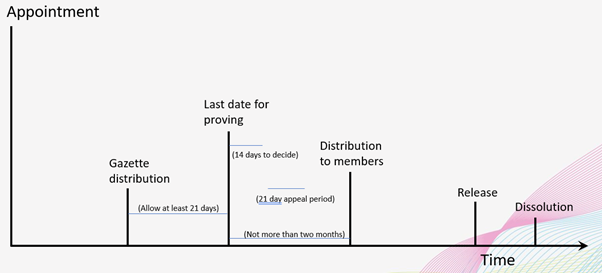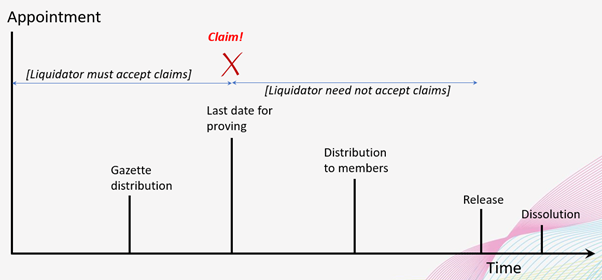In his latest Coffee Break Briefing webinar, Frettens’ own Insolvency Guru Malcolm Niekirk looked at dealing with solvent liquidations with no tax clearance.
This is the summary of that briefing.
If you'd like to watch the webinar back, you can do so below, if not, read on for our summary...
Quick Links
- Why are we talking about this now?
- Why would you ask for clearance?
- What your options are
- The timetable
- Dealing with HMRC
- Some things to look out for
Why are we talking about this now?
Over the years, HMRC have had increasing difficulty in coping with clearance requests and had made plenty of steps to try and alleviate that strain. But, ultimately, as of 6th December 2023, HMRC will no longer answer requests for clearance.
This applies particularly to liquidators closing MVLs, but is now a policy for all insolvencies.
So, those old MVLs that you've been waiting perhaps 18 months or more for a clearance request for? You're never going to get it, so you just need to get on and close that MVL now!
Why would you ask for clearance?
As part of HMRC’s announcement, they very helpfully summarised all of the statutory basis
for asking for clearance and the case law and other best guidance that the whole procedure was based on.
It turns out that there was absolutely no legal basis whatsoever behind HMRC granting clearance. It was one of those things that just grew up through custom and practice and HMRC had always obliged liquidators’ requests.
Why did IPs ask for clearance?
Well the truth is they didn't always do so. It was not that unusual to close an MVL without tax clearance, particularly in long running MVLs where it did seem to be taking an inordinately long time to get clearance.
Clearance would give you ‘comfort’ that HMRC had no live issues and that, having distributed the assets, you were not now going to get a claim.
But clearance didn’t always mean that. It was heavily caveated so that HMRC would reserve the right to reopen anything that needed proper investigation following clearance. You always knew there was an issue, if they refused clearance (though it didn’t happen often).
Are we better off without a clearance procedure? It’s certainly possible. We may be able to close MVLs much faster and more efficiently now. Only time will tell.
What your options are
I think there are three phases to the liquidation that you need to think about:
Pre-appointment
You’ll need to get information from the directors and their accountant.
You should undertake an objective assessment of the company’s tax affairs, considering the quality of accounting records, whether all returns and tax has been paid and whether there are any current HMRC enquiries.
Also make a subjective assessment to work out how reliable the directors are, how good they have been at dealing with the company’s tax affairs, how well they’ve followed advice, how diligent they’ve been etc.
At this stage, you are identifying and recording any issues and measuring the risk.
Warranties and representations
It may be worth getting the directors to sign a letter of representation, where they will tell you as a legally binding commitment that, to their best of their knowledge and having made all appropriate enquiries, the company’s tax affairs are closed (aside from any issues they disclose).
If then additional issues do exist that the director hasn’t disclosed, you can go back to them and explain that you took the job on the basis that the company’s affairs were according to what was disclosed.
Indemnities
If a distribution has been made to shareholders soon after your appointment, you might not have had the chance to run the statutory procedures to ask creditors to prove their claims.
You’ll want the option of calling back distributions to shareholders, triggered by an unexpected claim by HMRC.
Indemnities can be quite open ended and the shareholders might see that there is a risk that HMRC will see the opportunity of presenting late claims, even after the company has been dissolved, because they might think that there’s a good chance that there will be an indemnity in the liquidation.
Shareholders might become more reluctant to sign indemnities. They might think the indemnity, of itself, increases the risk of HMRC making a late claim. They might think the indemnity gives HMRC a way to pursue a claim when otherwise it would have none. For this reason, indemnities may be more closely negotiated in the future. They may become more limited in scope, or duration.
During the liquidation
- File returns
- Pay your tax
As liquidator, you will, of course, file your tax returns when they are due and pay the tax that is due during the liquidation!
Ending the liquidation
I think it is going to be really important from now on that you close every MVL completely by the book, following the statutory procedure of advertising for claims.
You will wait for at least 21 days for claims to come in before paying the distribution to shareholders (within two months of the last date for proving claims).
The statutory procedure does allow you to:
- reduce the proposed distribution if you need to provide against a claim which is difficult to assess,
- postpone the distribution if that is the only sensible option.
If you follow the procedure by the book, you are personally protected as liquidator.
But the statutory procedure is intended only to protect you as liquidator, not the company. It is still possible for creditors to put late claims in against the company.
Related: MVLs and indemnities to shareholders – a full guide to the statutory procedure
The timetable for advertising for claims by the book
From gazette distribution, 21 days needs to be allowed before the last date for proving. From then, there is a 14-day period for a decision to be made and a subsequent 21-day appeal period.
The time between the final date for proving and distribution to members must be no longer than two months.

In terms of dealing with claims, up until the last date for proving, if a claim comes in and it's good you have to accept it. After the last date for proving, if a claim comes in, you are not obliged to accept it. As you can see from the below diagram.

How to deal with HMRC
I suggest you should:
- Treat them as an unquantified creditor right from the start,
- Give them notice of an intended distribution,
- Gazette the proposed distribution.
If you receive no reply by the last day for proving you should:
- Write to them within 14 days,
- Formally reject all and any claims they might have on the ground that they have not proven for any claim,
- Advise them that they have 21 days to appeal to court.
What to look out for
Suppose HMRC want to make a late claim. They can either restore the company, if it has been resolved, or use ‘secondary liability’ provisions.
If they choose to restore the company and there is an indemnity then, in many cases, it will still be binding on the members. The new liquidator appointed on the restoration of the company may have a right to claim on that indemnity.
So, you might want to look at some of the cases that are now closing that you opened before 6th December 2023 and think about whether it would appropriate to formally release the shareholders from any Indemnity that they have given.
Alternatively, HMRC might be looking at ‘secondary liability’ provisions to claim from third parties third parties. This might include:
- Other group companies
- Directors
- Shareholders
- The liquidator
This shouldn't be an issue for you as liquidator if you followed the statutory procedure.
One type of secondary liability claim that HMRC may raise is a claim under schedule 13 of the Finance Act 2020. You can find out more about these claims here.
Late claims
Suppose HMRC makes a late claim. What should you do?
If you've got a representation letter from the directors then you will be relying on that and the directors will have acknowledged that you're relying on that. This will give you a measure of protection.
When first engaged, you should advise the directors on:
- The need for the company to take and follow tax advice,
- The risk that HMRC might claim at any time, noting that:
- You will usually be duty-bound to accept the claim (if good) but, when you are not, you may still decide to accept it.
- The cost of the claim is likely to pass to the members, even if they claim after the liquidation has closed.
It’s not just tax that can be an unknown unexpected claim, there are other creditors who might make similar claims such as former landlords. So, make sure to ask for disclosure in your representation letter in wide terms.
In summary
Make sure that you are following good pre-appointment due diligence procedures with:
- Investigation check list
- Letter of representation
- Solid indemnity
- Appropriate advice to the shareholders
And, when closing, ensure that you:
- Follow the statutory procedure
- Formally reject HMRC’s claim (even if they’ve not claimed)
- Remind the shareholders there’s still a risk from HMRC and any other contingent and unliquidated creditors
Upcoming events
Thanks for reading this summary…
My next Coffee Break Briefing will be on Monday 15th April, where I’ll be talking about, and de-bunking, legal myths and old laws relating to insolvency. Sign up for free here.
Our Third Annual all-day in-person Insolvency Conference will be taking place on 7th June 2024 in Brockenhurst, in the heart of the new forest. Secure your place here.
Make sure you’re subscribed to our email list to receive event information and webinar links straight to your inbox.
Specialist Insolvency Solicitors
If you have any questions after reading this article, please don’t hesitate to get in touch with our bright and experienced team.
Call us on 01202 499255, or fill out the form at the top of this page, for a free initial chat.




Comments